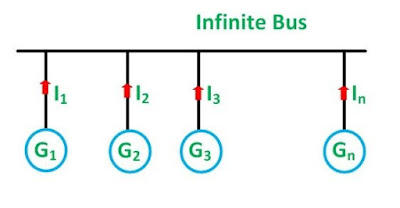For understanding the concept of Infinite Bus, we will take some examples. Suppose we take an isolated synchronous generator of capacity 100 kW and supplying a load of, say 50 kW, at 50 Hz and rated voltage, say 400 V.
Now if we add a load of 20 kW what will happen?
The frequency (speed) and terminal voltage will reduce instantly say 49 Hz and 390 V, before you correct them. Instead if we add only 10 kW the result will be same, with frequency and voltage of 49.5 Hz and 395 V. Next time, if we keep reducing the applied load….
With say 1 kW addition frequency and voltage may be 49.95 Hz and 299.5 V
If we now add 0.1 kW (100 W) instead there may not be any measurable change in frequency and voltage. So we can say that for a load up to 100 W the 100 kW machine is an infinite bus.
This example is used to illustrate the concept of an infinite bus. All the numerical values for frequency and voltage used above are not calculated but assumed for illustration only.
In our day to day routine, in cities, if we switch on a 60 W bulb or a tube light you don’t notice anything electrically abnormal. But if you switch on an Air Conditioner (without a Voltage Regulator) you can clearly notice a sudden voltage dip which recovers.
Theoretically an infinite bus is one where the frequency and voltage remain constant irrespective of the amount of load on it.
An infinite bus, to satisfy the above constraints, is represented by an equivalent generator having infinite moment of Inertia, M so that there will be no change in speed for any load addition and zero synchronous reactance, Xs so that there is no voltage drop for any load current and V = E, Induced generator emf.
In short infinite bus has number of generator connected to it and that means it has infinite active and reactive power capabilities. It can maintain its terminal voltage, frequency and any loading condition.

What is active and reactive power
You can read Active, Reactive and Apparent power.
Where is infinite bus located in power system generation?